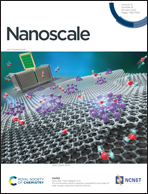Thermal transport in metal-NbOx-metal cross-point devices and its effect on threshold switching characteristics†
Abstract
Volatile threshold switching and current-controlled negative differential resistance (NDR) in metal–oxide-metal (MOM) devices result from thermally driven conductivity changes induced by local Joule heating and are therefore influenced by the thermal properties of the device-structure. In this study, we investigate the effect of the metal electrodes on the threshold switching response of NbOx-based cross-point devices. The electroforming and switching characteristics are shown to be strongly influenced by the thickness and thermal conductivity of the top-electrode due to its effect on heat loss from the NbOx film. Specifically, we demonstrate a 40% reduction in threshold voltage and a 75% reduction in threshold power as the thickness of the top Au electrode is reduced from 125 nm to 25 nm, and a 24% reduction in threshold voltage and 64% reduction in threshold power when the Au electrode is replaced by a Pt electrode of the same thickness of NbOx film, due to its lower thermal conductivity. Lumped element and finite element modelling of the devices show that these improvements are due to a reduction in heat loss to the electrodes, which is dominated by lateral heat flow within the electrode. These results clearly demonstrate the importance of the electrodes in determining the electroforming and threshold switching characteristics of MOM cross point devices.



 Please wait while we load your content...
Please wait while we load your content...